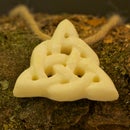Introduction: Brick Bridge for Your Nativity Scene or Tabletop Game
My girlfriend loves to make big and elaborate nativity scenes at home, and this year she asked me to prepare a bridge for a rivulet. So here I am with an instructable just for this.
I wanted to make a bridge that looked approximate and ramshackle, and made with real bricks. I decided, then, to use a kind of putty that hardens drying on air that becomes like terracotta.
P.S.
The brick bridge was prepared for a nativity scene but it can be used on a terrain for a tabletop wargame (i.e. Warzone, Hordes, Confrontation, Warhammer), thus when Christmas will be over I am going to use the bridge with my lead soldiers!
The close-up pictures were taken with a Pentax K10 D and a Tamron AF 90mm f/2.8 SP Di macro lens.The other pictures, with a Pentax SMC-DA 16-45mm f/4 ED AL zoom lens.
Step 1: Materials
Materials used:
- Cardboard;
- Sheets of paper;
- Das (http://www.fila.it/i-marchi/das.aspx), white and terracotta;
- White glue;
- Glue stick;
- Sand;
- Acrylic paints.
Das is a mineral putty that hardens drying on air. It is made by an Italian company, and I do not know where it can be found abroad. But maybe there are some equivalent products out there, or it is very common and I am not aware of that.
Step 2: Tools
Tools:
- Printer;
- Ruler;
- Utility knife;
- Scissors;
- Brushes;
- Toothpicks;
- Small clamps.
Step 3: The Project
Before starting to build my bridge I wanted a project of it to have a good starting point.
As a first step i drew it by hand and then scanned it to trace it with Inkscape (http://inkscape.org/).
Having traced it to make a papercraft model out of it is a short step with inkscape.
I added the project to this instructable so you can print it and build it.
The tricky part of the project was to calculate the length of the top of the parapet and of the street, because it was made with a Bezier curve. But I found some C code that did just than, and I wrote a small program to calculate the length. The length of the arc was really easy, though. (Who said pi?)
Unfortunately later I discovered that those lengths are subject to the building process and to the weight of the cardboard used. A heavy cardboard used on the arc can change its length also of 1 or two millimeters. You should be careful with that.
Attachments
Step 4: Printing, Cutting and Folding
When the project was finished I printed it on a sheet of paper then glued the paper on a cardboard. With a good printer you can print it directly on cardboard.
Do not use a heavy cardboard because it would be very hard to fold and glue it; I am talking of my experience because the one that I used was pretty heavy and I had problems.
If it feels too light it is not a big problem because you are going to glue all the bricks on it making it stronger, just make sure that your cardboard can stand the glue.
Cutting is easy but a little long, I will not cover this part.
To fold straight lines I suggest to use the edge of a ruler as a guide. Hold the piece against the edge with the folding line on the edge, then press hard with your thumb to make a mark. Bend also all the small flaps for gluing.
Step 5: Bending the Street and the Arc
The street and the arc are not to be folded with hard edges because they need to be round.
For gently rounding them you can use a rounded edge of a table. Hold the arc against the edge and, pressing it slightly, go up and down so it will bend.
Step 6: Gluing Side Walls
I used two kind of glues a stick glue for quick gluing and to prepare the pieces for the White Glue.
First glue one of the sides of the wall to the top, then glue the other with white glue.
Hold the pieces with small clamps.
Step 7: Gluing Arc and Street
For this step I used just white glue. Glue side walls on the base of the bridge and on the arc.
If you used heavy cardboard now it will get tricky because the arc length will probably be wrong. If the arc is 1 mm narrower because the flaps are too thick the error on the length will be of about 3 mm, and that is a lot!
So be careful here.
Regarding the street, I wanted to be almost parallel to the terrain at the edges, so I put some glue on the inside of the fold and pressed it with clamps. I wanted the street to follow the dotted line on the side wall.
I repeated the procedure on the other side and sealed the long sides of the street with a lot of glue. Before closing the street i also put some glue on the top of the arc to make everything stronger.
Step 8: Masonry (building Bricks and Stone Tiles)
For this dirty and smelly step I used some Das (http://www.fila.it/i-marchi/das.aspx), that is a mineral putty that hardens drying on air. It is made by and Italian company and I do not know its name in English, sorry.
It comes of two colors: white and terracotta. I wanted to have a brick bridge with some stone inlays (keystone and tiles) so I had to color the white Das with some black to turn it gray.
Having to color it anyway I tried to make some red gradients on the terracotta color using some white and yellow.
Step 9: Coloring the Das
To color the Das I used some acrylic paint embedding it in the putty.
Use gloves because this is a very dirty step! Also the more color you put, the more sticky it gets.
Steps:
- Make a litte cup with the Das;
- Put on it a toothpick with some color;
- Close the cup on it;
- Pull out the toothpick letting all the color on the inside;
- Mix it.
To make color gradients you can roughly mix some uncolored Das with the colored one.
Step 10: Shaping the Bricks
Flatten the Das on a table and cut it in small straight lines and then cut it again.
Use a hobby knife to cut the pieces and put some
Let the bricks dry.
Keep all the pieces, also bad ones: they can be useful on the future.
Step 11: Gluing the Bricks
First of all you should start with the keystone as a reference, then build the arc and then the rest. As it happens on real constructions, bridges are built on the main arcs and around them.
As usual I used white glue on the bricks using a palette knife to spread it on them. Tiny pieces of Das and malformed bricks now come handy to fill gaps
On the inside of the walls a couple of rows were sufficient for me, but on the top I had to add tiny bits to fill the gaps. Finally a row of stone tiles on the top.
As an embellishment I used four small balls that I made from leftover Das.
Step 12: Making the Road
For the road I glued some sea sand on the street:
- Put the glue where you want to glue the sand;
- Put an excess of sand on the glue;
- Wait until the glue is dried;
- Turn upside down the bridge and tap it to remove the excess of sand.
Repeat the procedure a couple of times until the sand is fully glued.
Step 13: Done!
I really like how it turned out! Also my girlfriend likes it and asked me to build some houses with the same technique.
It has a feeling of antique and ruined bridge but with some embellishments. I like how the bricks look sometimes broken of wrongly put.
Also Das, being made of a mineral compound, it has a good thermal conductivity so it feels cold, like real stone.
Here are some picture of the bridge in a small diorama with a sheepherder. Grass is made with some moss and the water with aluminum foil.
I also put a picture of the bridge with some lead soldiers that I painted. I know it is not proper for a nativity scene, but I could not resist!
Participated in the
Holiday Gifts Contest














